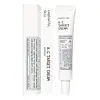What's inside
What's inside
 Key Ingredients
Key Ingredients

 Benefits
Benefits

 Concerns
Concerns

 Ingredients Side-by-side
Ingredients Side-by-side

Water
Skin ConditioningGlycerin
HumectantButylene Glycol
HumectantPropanediol
SolventCyclopentasiloxane
EmollientHelianthus Annuus Seed Oil
EmollientGlyceryl Acrylate/Acrylic Acid Copolymer
HumectantSodium Polyacrylate
AbsorbentXylitol
HumectantCaprylic Acid
CleansingGlyceryl Stearate
EmollientDimethicone
EmollientPanthenol
Skin ConditioningSodium Hyaluronate
HumectantCaprylyl Glycol
EmollientParfum
MaskingPentasodium Tetracarboxymethyl Heptadecanoyl Dipeptide-12
AntiseborrhoeicWater, Glycerin, Butylene Glycol, Propanediol, Cyclopentasiloxane, Helianthus Annuus Seed Oil, Glyceryl Acrylate/Acrylic Acid Copolymer, Sodium Polyacrylate, Xylitol, Caprylic Acid, Glyceryl Stearate, Dimethicone, Panthenol, Sodium Hyaluronate, Caprylyl Glycol, Parfum, Pentasodium Tetracarboxymethyl Heptadecanoyl Dipeptide-12
Aloe Barbadensis Leaf Water
MaskingButylene Glycol
HumectantHelianthus Annuus Seed Oil
EmollientGlycerin
HumectantZinc Oxide
Cosmetic ColorantCetearyl Alcohol
EmollientDimethyl Sulfone
SolventBetaine
HumectantPolysorbate 60
EmulsifyingElaeis Guineensis Oil
EmollientElaeis Guineensis Kernel Oil
EmollientCetearyl Olivate
Sorbitan Olivate
Emulsifying1,2-Hexanediol
Skin ConditioningCalamine
AbsorbentDimethicone
EmollientIllicium Verum Fruit Extract
PerfumingScutellaria Baicalensis Root Extract
AstringentXanthan Gum
EmulsifyingMelaleuca Alternifolia Leaf Oil
AntioxidantEthyl Hexanediol
SolventAsiaticoside
AntioxidantAsiatic Acid
Skin ConditioningMadecassic Acid
Skin ConditioningAloe Barbadensis Leaf Water, Butylene Glycol, Helianthus Annuus Seed Oil, Glycerin, Zinc Oxide, Cetearyl Alcohol, Dimethyl Sulfone, Betaine, Polysorbate 60, Elaeis Guineensis Oil, Elaeis Guineensis Kernel Oil, Cetearyl Olivate, Sorbitan Olivate, 1,2-Hexanediol, Calamine, Dimethicone, Illicium Verum Fruit Extract, Scutellaria Baicalensis Root Extract, Xanthan Gum, Melaleuca Alternifolia Leaf Oil, Ethyl Hexanediol, Asiaticoside, Asiatic Acid, Madecassic Acid
 Reviews
Reviews

Ingredients Explained
These ingredients are found in both products.
Ingredients higher up in an ingredient list are typically present in a larger amount.
Butylene Glycol (or BG) is used within cosmetic products for a few different reasons:
Overall, Butylene Glycol is a safe and well-rounded ingredient that works well with other ingredients.
Though this ingredient works well with most skin types, some people with sensitive skin may experience a reaction such as allergic rashes, closed comedones, or itchiness.
Learn more about Butylene GlycolDimethicone is a type of synthetic silicone created from natural materials such as quartz.
What it does:
Dimethicone comes in different viscosities:
Depending on the viscosity, dimethicone has different properties.
Ingredients lists don't always show which type is used, so we recommend reaching out to the brand if you have questions about the viscosity.
This ingredient is unlikely to cause irritation because it does not get absorbed into skin. However, people with silicone allergies should be careful about using this ingredient.
Note: Dimethicone may contribute to pilling. This is because it is not oil or water soluble, so pilling may occur when layered with products. When mixed with heavy oils in a formula, the outcome is also quite greasy.
Learn more about DimethiconeGlycerin is already naturally found in your skin. It helps moisturize and protect your skin.
A study from 2016 found glycerin to be more effective as a humectant than AHAs and hyaluronic acid.
As a humectant, it helps the skin stay hydrated by pulling moisture to your skin. The low molecular weight of glycerin allows it to pull moisture into the deeper layers of your skin.
Hydrated skin improves your skin barrier; Your skin barrier helps protect against irritants and bacteria.
Glycerin has also been found to have antimicrobial and antiviral properties. Due to these properties, glycerin is often used in wound and burn treatments.
In cosmetics, glycerin is usually derived from plants such as soybean or palm. However, it can also be sourced from animals, such as tallow or animal fat.
This ingredient is organic, colorless, odorless, and non-toxic.
Glycerin is the name for this ingredient in American English. British English uses Glycerol/Glycerine.
Learn more about GlycerinHelianthus Annuus Seed Oil is the oil derived from the seeds of a Sunflower. Sunflower seed oil is non-fragrant. It is an emollient, meaning it helps to soften the skin.
Sunflower seed oil contains many fatty acids. The fatty acids found in sunflower seeds include (from highest amount to least): linoleic acid, myristic acid, palmitic acid, stearic acid, arachidic acid, oleic acid, and linolenic acid.
These fatty acids help the skin create ceramides. Ceramides play a role in repairing the skin barrier.
Helianthus Annuus Seed Oil helps moisturize the skin. This in turn helps the skin look more rejuvenated and smoother.
Sunflowers are rich in vitamin E.
Historians believe Indigenous cultures of North America domesticated sunflowers before corn. Thus they relied on sunflower oil for a variety of uses. One such use is moisturizing skin and hair.
Sunflower seed oil may not be fungal acne safe. We recommend speaking with a professional if you have any concerns.
Learn more about Helianthus Annuus Seed Oil